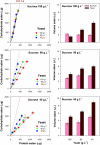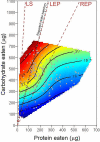Lifespan and reproduction in Drosophila: New insights from nutritional geometry
- PMID: 18268352
- PMCID: PMC2268165
- DOI: 10.1073/pnas.0710787105
Lifespan and reproduction in Drosophila: New insights from nutritional geometry
Abstract
Modest dietary restriction (DR) prolongs life in a wide range of organisms, spanning single-celled yeast to mammals. Here, we report the use of recent techniques in nutrition research to quantify the detailed relationship between diet, nutrient intake, lifespan, and reproduction in Drosophila melanogaster. Caloric restriction (CR) was not responsible for extending lifespan in our experimental flies. Response surfaces for lifespan and fecundity were maximized at different protein-carbohydrate intakes, with longevity highest at a protein-to-carbohydrate ratio of 1:16 and egg-laying rate maximized at 1:2. Lifetime egg production, the measure closest to fitness, was maximized at an intermediate P:C ratio of 1:4. Flies offered a choice of complementary foods regulated intake to maximize lifetime egg production. The results indicate a role for both direct costs of reproduction and other deleterious consequences of ingesting high levels of protein. We unite a body of apparently conflicting work within a common framework and provide a platform for studying aging in all organisms.
Conflict of interest statement
The authors declare no conflict of interest.
Figures





References
-
- Weindruch R, Walford RL. The Retardation of Aging and Disease by Dietary Restriction. Springfield, IL: Charles C Thomas; 1988.
-
- Partridge L, Brand MD. Dietary restriction, longevity and ageing–the current state of our knowledge and ignorance. Mech Ageing Dev. 2005;126:911–912.
-
- Nemoto S, Finkel T. Ageing and the mystery at Arles. Nature. 2004;429:149–152. - PubMed
-
- Merry BJ. Molecular mechanisms linking calorie restriction and longevity. Int J Biochem Cell Biol. 2002;34:1340–1354. - PubMed
-
- Guarente L, Kenyon C. Genetic pathways that regulate ageing in model organisms. Nature. 2000;408:255–262. - PubMed
Publication types
MeSH terms
Substances
Grants and funding
LinkOut - more resources
Full Text Sources
Other Literature Sources
Molecular Biology Databases

